Hydrophobic Antiwetting of Aquatic UAVs: Static and Dynamic Experiment and Simulation
Abstract
:1. Introduction
2. Materials and Methods
2.1. Fabrication and Characterization
2.2. Devices and Analysis
2.2.1. Experimental Equipment Configuration and Analysis
2.2.2. Simulations
3. Results
3.1. Antiwetting Behavior of the Stationary Model
3.1.1. Droplets Impacting on Static Hydrophilic Model
3.1.2. Promotion of Antiwetting by Static Superhydrophobic Surfaces
3.2. Antiwetting Properties of Models in Motion
3.2.1. Coupled Desorption Properties of Vibration and Wettability
3.2.2. Liquid Repellency of the Linearly Moving Aquatic UAV
3.3. Simulated Antiwetting Properties of Surfaces of Moving Models
4. Discussion
Effects of Surface Wettability and Motion on Liquid Adhesion and Bouncing Behavior
5. Conclusions
- (1)
- The “edge effect” produced by the superhydrophobic surface significantly affects the mass redistribution within the droplet, so that the time for the first detachment of the derived droplet is reduced by 67% compared with the theoretical contact time, and the time required for complete detachment from the surface is reduced by 40%;
- (2)
- Compared with models with hydrophilic surfaces, the superhydrophobicity of the surface enables an 87.5% reduction in precipitation loading, so that the model behaviors are almost unaffected by precipitation;
- (3)
- The superhydrophobic surface has an excellent antiwetting effect when combined with model vibration and forward motion; the motion reduces the surface-droplet adhesion, accelerates the solid–liquid separation, produces directional bounce, and maintains flight stability;
- (4)
- LBM numerical simulations show that, in forward motion, the lateral-pressure distribution of the fluid on a model with hydrophilic surfaces is uneven, which affects the lateral mechanical balance of the aquatic UAV. The lateral-pressure distribution of the fluid on the model with superhydrophobic surfaces is relatively uniform, which is beneficial in maintaining flight balance;
- (5)
- A rain droplet falling onto a hydrophilic surface loses kinetic energy, which diminishes its chance of separation. After falling onto a superhydrophobic substrate, rain droplets can still maintain a high level of kinetic energy, the average absolute velocity is increased by up to 32%, and the derived droplets have enough kinetic energy to quickly separate, with no inclination to pin or adsorb onto the surface. The details of the superhydrophobicity can affect the direction of bounce favorably toward the rear of the craft.
Supplementary Materials
Author Contributions
Funding
Institutional Review Board Statement
Informed Consent Statement
Data Availability Statement
Conflicts of Interest
References
- Rudich, R.D. Weather-Involved US Air Carrier Accidents 1962–1984. In Proceedings of the 24th Aerospace Sciences Meeting, Reno, NV, USA, 6–9 January 1986; Volume 86, p. 327. [Google Scholar]
- Siddall, R.; Kovač, M. Launching the AquaMAV: Bioinspired Design for Aerial-Aquatic Robotic Platforms. Bioinspir. Biomim. 2014, 9, 031001. [Google Scholar] [CrossRef] [PubMed]
- Ortega-Jimenez, V.M.; Dudley, R. Aerial Shaking Performance of Wet Anna’s Hummingbirds. J. R. Soc. Interface 2012, 9, 1093–1099. [Google Scholar] [CrossRef] [PubMed] [Green Version]
- Smyrnaios, D.N.; Pelekasis, N.A.; Tsamopoulos, J.A. Boundary Layer Flow of Air Past Solid Surfaces in the Presence of Rainfall. J. Fluid Mech. 2000, 425, 79–110. [Google Scholar] [CrossRef]
- Yarin, A.L.L. Drop impact dynamics: Splashing, Spreading, Receding, Bouncing. Annu. Rev. Fluid Mech. 2006, 38, 159–192. [Google Scholar] [CrossRef]
- Hansman, R.J.; Craig, A.P. Low Reynolds Number Tests of NACA 64-210, NACA 0012, and Wortmann FX67-K170 Airfoils in Rain. J. Aircr. 1987, 24, 559–566. [Google Scholar] [CrossRef]
- Ashenden, R.; Marwftzt, J.D. A Comparison of the Air Force Water Spray Tanker Artificial Drizzle Cloud Distributions to the Natural Environment. In Proceedings of the 34th Aerospace Sciences Meeting and Exhibit, Reno, NV, USA, 15–18 January 1996. [Google Scholar]
- Adams, K.J. The Air Force Flight Test Center artificial icing and rain testing capability. In Proceedings of the 2nd Flight Testing Conference, Las Vegas, NV, USA, 16–18 November 1983. [Google Scholar]
- Cao, Y.; Wu, Z.; Xu, Z. Effects of Rainfall on Aircraft Aerodynamics. Prog. Aerosp. Sci. 2014, 71, 85–127. [Google Scholar] [CrossRef]
- Bilanin, A.J. Scaling Laws for Testing Airfoils under Heavy Rainfall. J. Aircr. 1987, 24, 31–37. [Google Scholar] [CrossRef]
- Ismail, M.; Yihua, C.; Bakar, A.; Wu, Z. Aerodynamic Efficiency Study of 2D Airfoils and 3D Rectangular Wing in Heavy Rain via Two-Phase Flow Approach. Proc. Inst. Mech. Eng. Part G J. Aerosp. Eng. 2014, 228, 1141–1155. [Google Scholar] [CrossRef]
- Yang, X.; Wang, T.; Liang, J.; Yao, G.; Liu, M. Survey on the Novel Hybrid Aquatic-Aerial Amphibious Aircraft: Aquatic Unmanned Aerial Vehicle (AquaUAV). Prog. Aerosp. Sci. 2015, 74, 131–151. [Google Scholar] [CrossRef]
- Peloquin, R.A.; Thibault, D.; Desbiens, A.L. Design of a Passive Vertical Takeoff and Landing Aquatic UAV. IEEE Robot. Autom. Lett. 2017, 2, 381–388. [Google Scholar] [CrossRef]
- Hang, K.; Lyu, X.; Song, H.; Stork, J.A.; Dollar, A.M.; Kragic, D.; Zhang, F. Perching and Resting-A Paradigm for UAV Maneuvering with Modularized Landing Gears. Sci. Robot. 2019, 4, eaau6637. [Google Scholar] [CrossRef]
- Gao, A.; Techet, A.H. Design Considerations for a Robotic Flying Fish. In Ocean 2011; IEEE: Piscataway, NJ, USA, 2011; pp. 1–8. [Google Scholar]
- Vasileiou, T.; Gerber, J.; Prautzsch, J.; Schutzius, T.M.; Poulikakos, D. Superhydrophobicity Enhancement through Substrate Flexibility. Proc. Natl. Acad. Sci. USA 2016, 113, 13307–13312. [Google Scholar] [CrossRef] [Green Version]
- Jiang, L.; Zhao, Y.; Zhai, J. A Lotus-Leaf-like Superhydrophobic Surface: A Porous Microsphere/Nanofiber Composite Film Prepared by Electrohydrodynamics. Angew. Chem. 2004, 43, 4338–4341. [Google Scholar] [CrossRef]
- Marmur, A.; Della Volpe, C.; Siboni, S.; Amirfazli, A.; Drelich, J.W. Contact Angles and Wettability: Towards Common and Accurate Terminology. Surf. Innov. 2017, 5, 3–8. [Google Scholar] [CrossRef] [Green Version]
- Wang, D.; Sun, Q.; Hokkanen, M.J.; Zhang, C.; Lin, F.Y.; Liu, Q.; Zhu, S.P.; Zhou, T.; Chang, Q.; He, B.; et al. Design of Robust Superhydrophobic Surfaces. Nature 2020, 582, 55–59. [Google Scholar] [CrossRef]
- Zhang, C.; Zheng, Y.; Wu, Z.; Wang, J.; Shen, C.; Liu, Y.; Ren, L. Non-Wet Kingfisher Flying in the Rain: The Water-Repellent Mechanism of Elastic Feathers. J. Colloid Interface Sci. 2019, 541, 56–64. [Google Scholar] [CrossRef]
- Zhang, C.; Wu, Z.; Zhang, X.; Yue, Y.; Wang, J. Effect of Feather Elasticity of Kingfisher Wing on Droplet Impact Dynamics. J. Bionic Eng. 2018, 15, 731–740. [Google Scholar] [CrossRef]
- Zheng, Y.; Zhang, C.; Wang, J.; Yang, L.; Shen, C.; Han, Z.; Liu, Y. Nonwet Kingfisher Flying in the Rain: The Tumble of Droplets on Moving Oriented Anisotropic Superhydrophobic Substrates. ACS Appl. Mater. Interfaces 2020, 12, 35707–35715. [Google Scholar] [CrossRef]
- Bormashenko, E.; Bormashenko, Y.; Stein, T.; Whyman, G.; Bormashenko, E. Why Do Pigeon Feathers Repel Water? Hydrophobicity of Pennae, Cassie-Baxter Wetting Hypothesis and Cassie-Wenzel Capillarity-Induced Wetting Transition. J. Colloid Interface Sci. 2007, 311, 212–216. [Google Scholar] [CrossRef]
- Guo, C.; Zhao, D.; Sun, Y.; Wang, M.; Liu, Y. Droplet Impact on Anisotropic Superhydrophobic Surfaces. Langmuir 2018, 34, 3533–3540. [Google Scholar] [CrossRef]
- Han, J.; Ryu, S.; Kim, H.; Sen, P.; Choi, D.; Nam, Y.; Lee, C. Anisotropic Drop Spreading on Superhydrophobic Grates during Drop Impact. Soft Matter 2018, 14, 3760–3767. [Google Scholar] [CrossRef]
- Whyman, G.; Bormashenko, E. How to Make the Cassie Wetting State Stable? Langmuir 2011, 27, 8171–8176. [Google Scholar] [CrossRef]
- Bormashenko, E.; Gendelman, O.; Whyman, G. Superhydrophobicity of Lotus Leaves versus Birds Wings: Different Physical Mechanisms Leading to Similar Phenomena. Langmuir 2012, 28, 14992–14997. [Google Scholar] [CrossRef]
- Zheng, Y.-H.Y.H.; Zhang, C.-C.C.C.; Sun, J.-H.J.H. The Technology and Application of Bionic Dynamic Dehydration on the Surface. Surf. Technol. 2021, 50, 28–39, 50. [Google Scholar]
- Lin, Y.; Chen, H.; Wang, G.; Liu, A. Recent Progress in Preparation and Anti-Icing Applications of Superhydrophobic Coatings. Coatings 2018, 8, 208. [Google Scholar] [CrossRef] [Green Version]
- Song, M.; Hu, D.; Zheng, X.; Wang, L.; Yu, Z.; An, W.; Na, R.; Li, C.; Li, N.; Lu, Z.; et al. Enhancing Droplet Deposition on Wired and Curved Superhydrophobic Leaves. ACS Nano 2019, 13, 7966–7974. [Google Scholar] [CrossRef] [PubMed]
- Liu, H.; Wang, Y.; Huang, J.; Chen, Z.; Chen, G.; Lai, Y. Bioinspired Surfaces with Superamphiphobic Properties: Concepts, Synthesis, and Applications. Adv. Funct. Mater. 2018, 28, 1707415. [Google Scholar] [CrossRef]
- Strack, O.E.; Cook, B.K. Three-Dimensional Immersed Boundary Conditions for Moving Solids in the Lattice-Boltzmann Method. Int. J. Numer. Methods Fluids 2007, 55, 103–125. [Google Scholar] [CrossRef]
- Murr, L.E. Frontiers of 3D Printing/Additive Manufacturing: From Human Organs to Aircraft Fabrication. J. Mater. Sci. Technol. 2016, 32, 987–995. [Google Scholar] [CrossRef]
- Gupta, R.; Vaikuntanathan, V.; Sivakumar, D. Superhydrophobic Qualities of an Aluminum Surface Coated with Hydrophobic Solution NeverWet. Colloids Surf. A Physicochem. Eng. Asp. 2016, 500, 45–53. [Google Scholar] [CrossRef]
- Gart, S.; Mates, J.E.; Megaridis, C.M.; Jung, S. Droplet Impacting a Cantilever: A Leaf-Raindrop System. Phys. Rev. Appl. 2015, 3, 044019. [Google Scholar] [CrossRef] [Green Version]
- Zheng, Y.; Zhang, C.; Wang, J.; Liu, Y.; Shen, C.; Yang, J. Robust Adhesion of Droplets via Heterogeneous Dynamic Petal Effects. J. Colloid Interface Sci. 2019, 557, 737–745. [Google Scholar] [CrossRef]
- Che, Z.; Matar, O.K. Impact of Droplets on Liquid Films in the Presence of Surfactant. Langmuir 2017, 33, 12140–12148. [Google Scholar] [CrossRef]
- Che, Z.; Matar, O. Impact of Droplets on Immiscible Liquid Films. Soft Matter 2018, 14, 1540–1551. [Google Scholar] [CrossRef] [Green Version]
- Che, Z.; Deygas, A.; Matar, O.K. Impact of Droplets on Inclined Flowing Liquid Films. Phys. Rev. E 2015, 92, 023032. [Google Scholar] [CrossRef] [Green Version]
- Ismail, N.I.; Kuang, S.; Yu, A. CFD-DEM Study of Particle-Fluid Flow and Retention Performance of Sand Screen. Powder Technol. 2021, 378, 410–420. [Google Scholar] [CrossRef]
- Tosco, V.; Monterubbianesi, R.; Orilisi, G.; Procaccini, M.; Grandini, S.; Putignano, A.; Orsini, G. Effect of Four Different Finishing and Polishing Systems on Resin Composites: Roughness Surface and Gloss Retention Evaluations. Minerva Stomatol. 2019, 69, 207–214. [Google Scholar] [CrossRef]


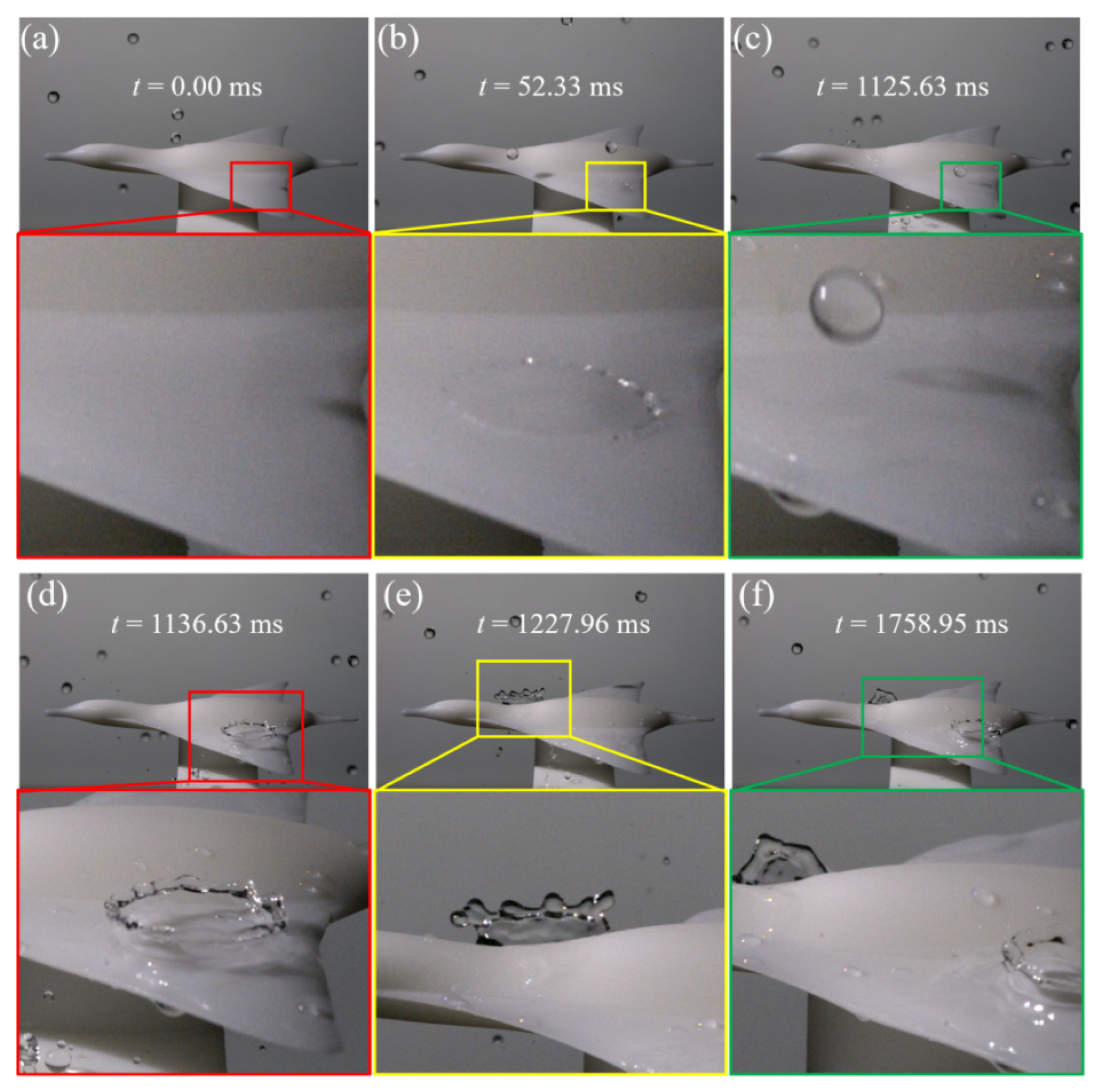

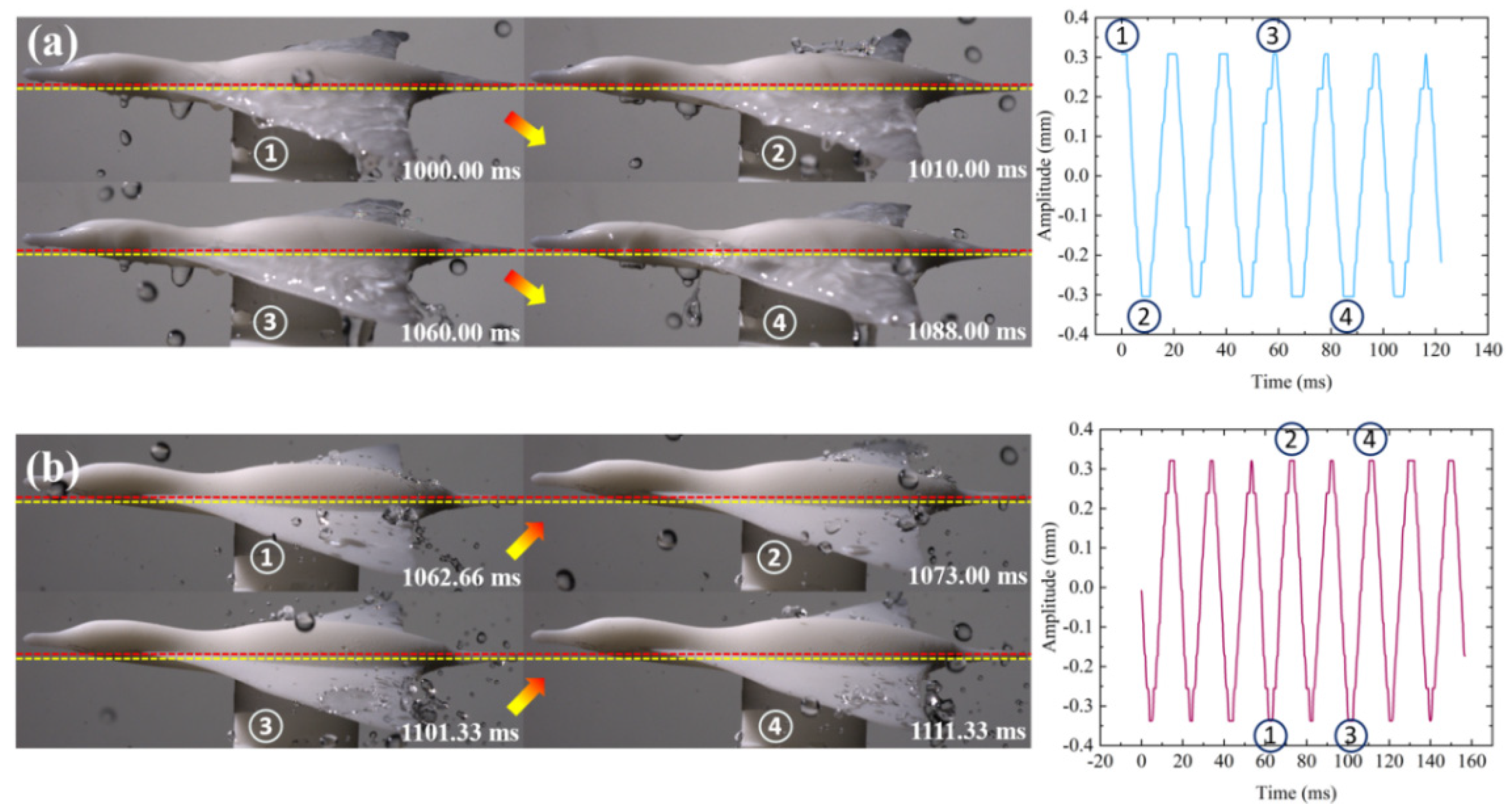
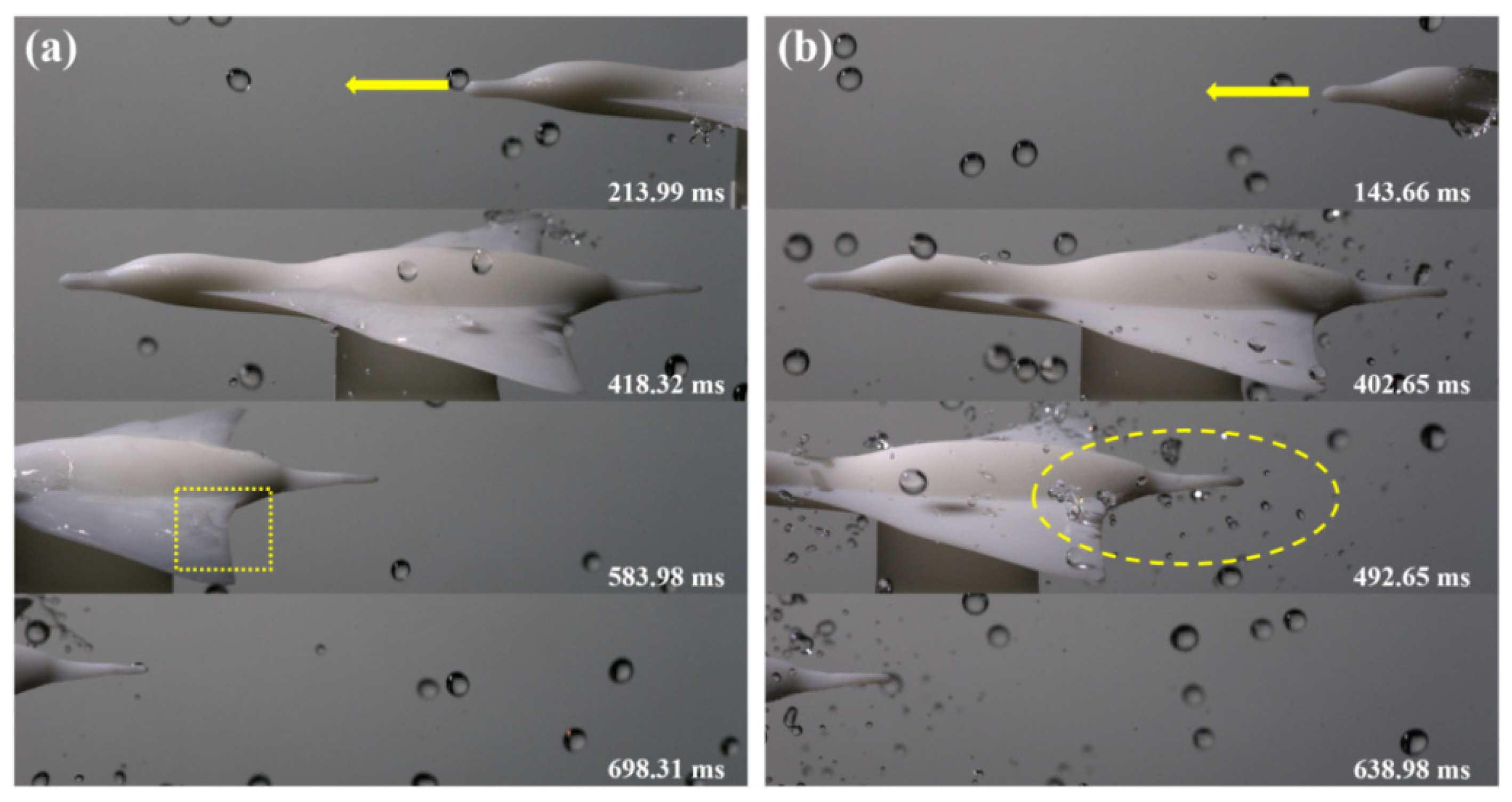
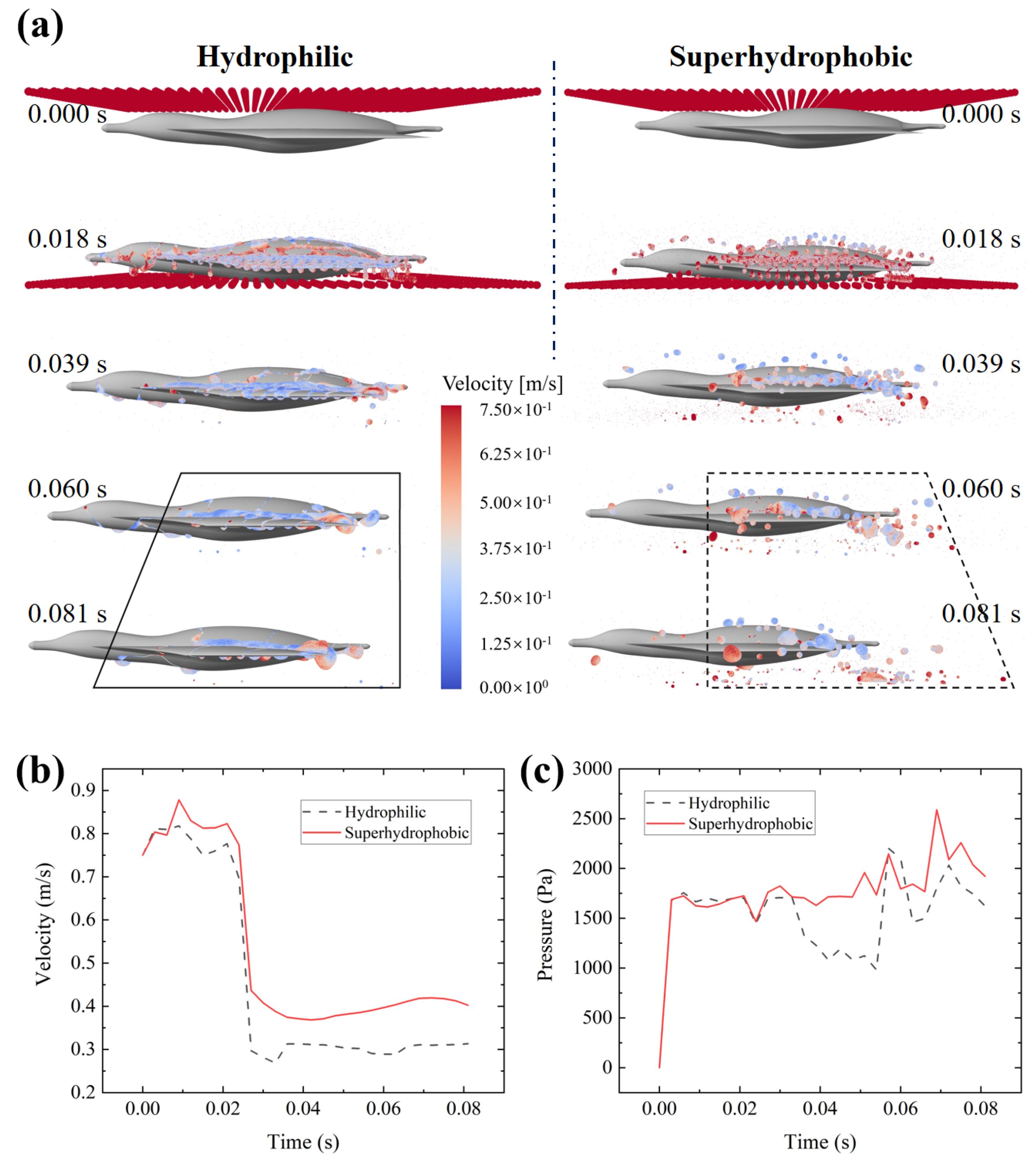
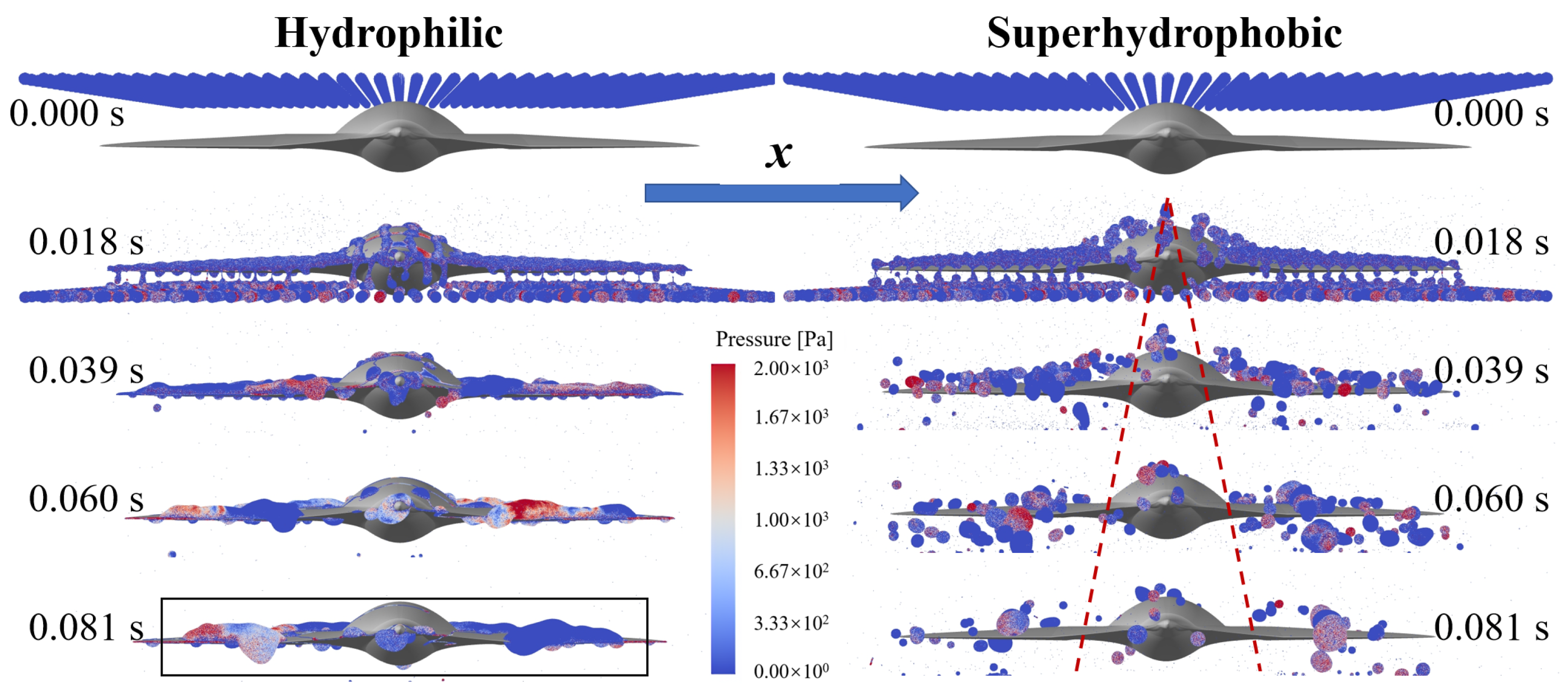


Publisher’s Note: MDPI stays neutral with regard to jurisdictional claims in published maps and institutional affiliations. |
© 2022 by the authors. Licensee MDPI, Basel, Switzerland. This article is an open access article distributed under the terms and conditions of the Creative Commons Attribution (CC BY) license (https://creativecommons.org/licenses/by/4.0/).
Share and Cite
Zheng, Y.; Huang, Z.; Zhang, C.; Wu, Z. Hydrophobic Antiwetting of Aquatic UAVs: Static and Dynamic Experiment and Simulation. Appl. Sci. 2022, 12, 7626. https://doi.org/10.3390/app12157626
Zheng Y, Huang Z, Zhang C, Wu Z. Hydrophobic Antiwetting of Aquatic UAVs: Static and Dynamic Experiment and Simulation. Applied Sciences. 2022; 12(15):7626. https://doi.org/10.3390/app12157626
Chicago/Turabian StyleZheng, Yihua, Zhimin Huang, Chengchun Zhang, and Zhengyang Wu. 2022. "Hydrophobic Antiwetting of Aquatic UAVs: Static and Dynamic Experiment and Simulation" Applied Sciences 12, no. 15: 7626. https://doi.org/10.3390/app12157626




